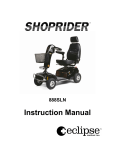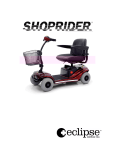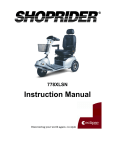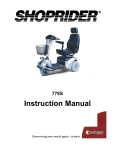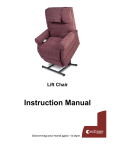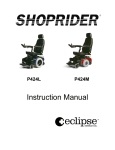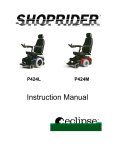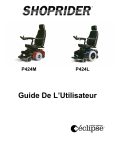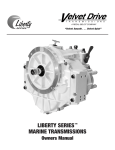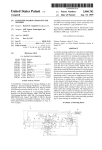Download Cobra 778 EL - Canada Scooters
Transcript
778EL Instruction Manual Table of Contents Introduction 2 EMI Warning 3 Safety Guidelines 5 Features 7 Free Wheel Mode 10 Operating Your Scooter 11 Battery Charging & Maintenance 15 Inspection & Maintenance 17 Trouble Shooting 20 Warranty 21 Specifications 22 Options 23 1 Introduction Congratulations on the purchase of your Shoprider scooter. Please carefully read this owner’s manual before attempting to use your scooter. After reading the manual if you still have any questions or concerns please feel free to contact your local authorized dealer. Model: 778EL Serial #: ________________________ Date Purchased: ________________________ Dealer Information: ________________________ 2 EMI Warning Electromagnetic Interface (EMI) From Radio Wave Sources Powered motorized scooters may be susceptible to electromagnetic interference (EMI), which is interfering electromagnetic energy (EM) emitted from sources such as radio stations, TV stations, amateur radio (HAM) transmitters, two-way radios, and cellular phones. The interference (from radio wave sources) can cause a powered scooter to release its brakes, move by itself or move in unintended directions. It also can permanently damage the powered scooter's control system. The sources of radiated EMI can be classified broadly into three types: 1. Hand-held portable transceivers (transmitters-receivers) with an antenna mounted directly on the transmitting unit. Examples include: citizens band (CB) radios, "walkie-talkies", fire and police transceivers, cellular telephones and other personal communication devices. **NOTE: some cellular telephones and similar devices transmit signals while they are ON, even when not being used. 2. Medium-Range mobile transceivers, such as those used in police cars, fire trucks, ambulances and taxis. These usually have the antenna mounted on the outside of the vehicle. 3. Long-range transmitters and transceivers, such as commercial broadcast transmitters (radio and TV antenna towers) and amateur (HAM) radios. **NOTE: So far as we know, other types of hand-held devices, such as cordless phones, laptop computers, AM/FM radios, TV sets, CD players, cassette players and small appliances, such as electric shavers and hair dryers, are not likely to cause problems to your powered scooter. Powered Scooter Electromagnetic Interference (EMI) Because EM energy rapidly becomes more intense as one moves closer to the transmitting antenna (source), the EM fields from hand-held radio sources (transceivers) are of special concern. It is possible, unintentionally, to bring high levels of EM energy very close to the powered scooter's control system while using these devices. This can affect powered scooter movement and braking. Therefore, the warnings listed below are recommended to prevent possible interference with the control system of the powered scooter. 3 Warnings The warnings listed below should reduce the chance of unintended brake release or powered scooter movement, which could result in serious injury. 1. Do not operate hand-held transceivers (transmitters-receivers) such as citizens band (CB) radios, or turn on personal communication devices, such as cellular phones, while the powered scooter is turned ON. 2. Be aware of nearby transmitters, such as radio or TV stations, and try to avoid coming close to them. 3. If unintended movement or brake release occurs, turn the powered scooter OFF as soon as it is safe to do so. 4. Be aware that adding accessories or components, or modifying the powered scooter, may make it more susceptible to EMI (NOTE: There is no easy way to evaluate the overall immunity of the powered scooter.) 5. Report all incidents of unintended movement or brake to the powered scooter dealer, and note whether there are sources of EMI nearby. 4 Safety Guidelines The user needs to be familiar with the operation of this scooter before using. Please read the following notes carefully to ensure safety at all times. Always make certain your scooter is in full working order before use. 1. Do not ride your scooter without reading this instruction manual first. 2. Do not exceed the maximum gradient outline for your scooter. 3. Do not carry passengers or exceed the maximum weight. 4. Do not mount or dismount your scooter, unless it has come to a full stop and is turned off. 5. Do not switch your scooter on with the forward/reverse lever depressed. 6. Do not mount or dismount your scooter unless the speed adjustment dial is set to minimum. 7. Do not backup your scooter onto uneven inclines or surfaces. Be cautious when traveling on slopes. 8. Do not drive your scooter in a confined space unless the speed adjustment dial is set to minimum. 9. Do not turn suddenly at full speed, especially on uneven or hilly ground. Failure to observe this may result in tipping of your scooter. 10. Do not drive your scooter unless the seat is locked into driving position. 11. Do not drive your scooter over deep, soft terrain (Loose gravel, soft dirt). 12. Do not operate your scooter when under the influence of alcohol or certain drugs, which may impair your safety. 13. Do not climb curb cut outs that exceed your scooter's capacity. Do not turn when negotiating curbs. Always approach curb cut outs at low speed and straight. 5 14. Always stop fully before changing direction (forward / reverse) 15. Always keep your feet on the scooter when driving. 16. Always proceed carefully while riding your scooter, especially when approaching a ramp or hill. 17. Always proceed carefully while riding on uneven surfaces. 18. Do not sit on your scooter while being transported in a moving vehicle. Always tie-down your scooter and transfer yourself to a vehicle seat. 19. Do not drive your scooter in deep water or clean with a high-pressure hose. 6 Features Tiller Adjustment The tiller of your scooter is uniquely designed to allow you to position it to a comfortable driving position. Your scooter’s tiller is very versatile, and can be adjusted to five different positions. To decide which position best fits your needs, carefully pull the large black ball that is located on the left side, at the base of tiller, and gently lower or raise the tiller. Once you are satisfied with the position of the tiller, simply release the black ball and the tiller will automatically lock for your safety. Using the Electric Seat Lift Your scooter comes equipped with an electric seat lift for easy height adjustment. To raise or lower your seat to your desired position, simply move the switch, located on the inside of the tiller, up to raise the seat or down to lower the seat. Once you release the switch, the seat will automatically lock to your desired position. Scooter Light Package Your scooter comes complete with a full light package. This package includes a front headlight, left and right turn signals plus a hazard light for emergencies. Front Headlight – To turn on and off your front headlight, simply press the round blue button located on the right side of the tiller, just under your forward lever. To shut off the headlight, press the blue button again. Left and Right Turn Signals – When making a turn always use your left and right turn signals. The turn signal switch is located on the top of your tiller just above your speed dial control. Simply flip the switch to the right or left to activate your turn signals. When done turning, just flip the switch back to its center position. 7 Hazard Lights – If your scooter breaks down or you need assistance, press the red button located on the left side of the tiller, just under the reverse lever. Once you have received assistance, press the red button again to turn it off. Adjusting Your Scooter Seat Your scooter has a fully adjustable seat for your comfort. Your deluxe captain seat will recline, slide up and back, and will swivel for your convenience. Recline - To manually recline your seat, simply pull your lever located on the lower left side of the seat and you will be able to adjust it to fit your desired convenience. Slide - To move closer or farther away from the tiller, depress the black lever located under the center of the seat and slide to your desired position. Swivel - To turn your seat left or right, depress the red lever located on the lower right side of the seat and you will easily be able to adjust the seat to the desired position. Control Features Your controls are located on the handle bar console, and they are: 1. On-Off Switch: Located in the center of the tiller console. Insert the key and turn it. You will notice the digital bar on the battery state indicator moves towards the right. Your scooter is ready to drive. To switch off your machine, turn the key counter clockwise. Make sure to remove the key when the vehicle is unattended. CAUTION: Do not switch to ‘off’ when scooter is moving. Failure to observe this will result in the motor brake being applied suddenly, and placing you in a dangerous situation. You should only switch ‘off’ when in motion in the case of an emergency. Continual use in this mode may cause undue stress to the drive system, and damage the main electronic speed control unit. Be extremely cautious on slopes. Sit upright in your seat or your scooter may become less stable. 8 2. Battery Indicator Gauge: Located at the top of your console. When your scooter is switched on the bar on the gauge will move across the scale from the left towards the right, indicating full charge batteries. As the power is used up in your batteries the red bars will move towards the left indicating the state of charge at the precise time. When the red bars are completely over to the right, the batteries are fully charged. When the red bars start to disappear, your batteries are losing power. It is wise to recharge your batteries when the two red bars remain. (See Batteries and Battery Charging section of this manual). 3. Speed Adjustment Dial: This allows you to pre-select your desired speed. The dial is proportional to speed, and can be set anywhere between 1 and 10 increments. Turn the dial knob counter-clockwise to "minimum" to decrease speed, and clockwise towards "maximum" to increase your speed. NOTE: When attempting to climb slopes, you will need to set the dial to "high" setting. Remember the higher the number you set your speed dial to, the faster your scooter will travel. 4. Free-Wheel Switch: Located on the back right side underneath the rear shroud, push the release switch down to disengage the brakes. This will enable you to free wheel the scooter and push it around. Thumb Lever Control Located under the handle bar grips. Your speed for forward and reverse motion is controlled here. The right thumb lever moves your scooter in a forward motion, and also controls the rate of speed by the proportional amount of pressure applied. The left thumb lever moves the scooter in a reverse motion and controls the rate of speed by the amount of pressure applied. Releasing the lever will return itself to the neutral position, and you will stop gently. You will note that you can obtain the reverse of this procedure by pulling the levers backwards with your thumb. CAUTION: If you are not an accomplished outdoors powered vehicle driver, we strongly recommend that you first practice in an open, safe area, free from traffic, preferably with a companion who can assist you. 9 Free Wheel Mode Free-wheeling is used when you want to move your unit without riding on it. If for reasons of convenience you need to free wheel your scooter, there are two ways in which this can be accomplished: By disengaging the electromagnetic brakes and by lifting the front of the unit and letting it ride on its antitippers. To disengage the electromagnetic brakes, with the power “OFF”, simply depress the freewheeling switch located underneath the shroud, just above the back right wheel. You can easily get to it without having to take the unit apart. When you are done moving your scooter always remember to depress the switch again. In the event that the unit had the batteries disconnected and therefore, unable to disengage the electromagnetic brakes, your scooter can still be freewheeled by lifting the front of the unit and pulling, using the base of the tiller as a secure handhold. Caution Notes: Never sit on your scooter with the free wheel in the disengaged position. When the free wheel device is disengaged, you do not have braking function. Do not park your scooter on a slope with the free wheel disengaged. If your scooter is in the free-wheel mode, when you depress the speed control you will not be able to move under motor power. Depress the free-wheel switch once again. You will hear a clicking sound of the brakes being re-applied to be able to start driving your scooter. General: If you are able to push your scooter, the free-wheel switch is on and the electromagnetic brakes are disengaged. Please check once more the abovementioned procedure for re-engaging the drive. 10 Operating Your Scooter Mounting For your first drive, make sure that you and your scooter are on a level surface. Make sure that the unit is off before sitting on it. Make certain that both of your feet are on the deck of the scooter. Insert the on/off key into its key slot, but leave it turned off. Next, turn the ‘speed adjustment dial’ to slow, and turn the ‘on/off’ key clockwise to the ‘on’ position. (The battery state indicator will move, and the red status lights will illuminate). Press the right thumb control to move in a forward motion. To stop, simply let go; the brakes will automatically be applied. CAUTION: Please take care not to have your thumb on the forward/reverse control lever when you switch ‘on’ your scooter; this will result in your scooter going into a fault mode. Switch ‘off’, then ‘on’ again, to clear the fault. Dismounting Always switch off your scooter before dismounting. Make sure that you dismount the unit on a level surface. Parking in Public If you need to park and leave your scooter, simply remove your key. This will keep the brake on and will make your scooter difficult to move. It is best to leave it in sight of someone (like a store assistant, etc.) who can watch it for you. Another precaution is to note your serial number and the date of purchase. Your serial number can be found on the lower section of the back frame of the scooter. Basic Driving Make certain that you are properly sitting on your scooter. Ensure that the ‘speed control dial’ is turned to slow for your first drive. When you have become more confident, you can increase the setting to a higher speed. Push the ‘thumb lever control’, as described earlier. You will very gently accelerate. Release the lever, 11 and you will gently stop. Practice these two basic functions until you get used to them. Steer the scooter by turning the handlebars in the direction you wish to maneuver. Be sure to remember to give a wide clearance when turning, so that the rear wheels follow the path of the front ones, instead of cutting short. Cutting short on pavement corners can mean that a back wheel will go off the pavement, causing a stability problem. Avoid this at all times by steering an exaggerated, wide arc around the obstacle. If you must steer in a tight spot, such as entering a doorway or when turning around, stop and turn the handle bars to where you want to go, then apply the power gently. This will make the scooter turn sharply. It will still go gently and with complete stability. Practice in an open area until you are proficient. Reversing requires attention. Be sure your ‘speed control dial’ is turned to ‘slow’ before you reverse. Push the left thumb reverse lever. Remember; when you reverse you have to steer in the opposite direction of the way you want to go. Practice is required, again use open space. REMEMBER: If it is a tight turn, turn your steering column before applying power. Steer wide of all corners and obstacles; please move slowly and with care. WARNING NOTE: Do not turn off your scooter while it is in motion. Failure to observe this warning may irreparably damage the main electronic speed control unit or drive transmission. Always slow your scooter down to a stationary position before you switch the scooter off. Control Through Tight Spots When you start using your scooter you will meet some obstacles that will require some practice to drive through smoothly. Here are some common problems, with tips that will help you master them quickly. You will soon be in control through doors, up and down ramps, up and over curbs, through grass and gravel, with surprising ease by following these tips. Control Through Doors Approach an unfamiliar door slowly, sizing it up. Does it have a knob or a push bar? Does it open towards you, or away? Think in terms of using the power of the scooter to do the work for you! You need not strain. 12 Hold the doorknob or bar in one hand and apply power with the other hand (remember that you can drive forward by using your left thumb to move the throttle lever towards you). If the door is self-closing, you can go through, allowing the door to close behind you. If the door is not self-closing, just stop when you are clear of the door and push it closed. If the door opens towards you, hold the knob or bar with one hand and gently let the reverse power do the work. When the door is open wide enough, go ahead quickly, leaving your hand on the door to keep it free of the scooter and letting go as you pass the doorjamb. This is an easy technique. Practice makes perfect. Remember; let your scooter do the work without wearing you out! Control on Ramps More and more buildings have ramps for wheelchair access. Some have a change of direction in the middle, and good cornering is required. Make a wide maneuver with your front wheel(s) around tight corners, so that your back wheels follow a wide arc to stay clear of the corner. If you stop while facing uphill, the automatic parking brake will hold you safe. To start again, simply push the forward direction lever, the parking brake will release and you will start to move. Going down the ramp, keep the speed dial set on ‘slow’. This will keep you in a safely controlled descent. If you wish to stop completely, release the control lever, and you will come to a gentle stop. Control Over Grass, Gravel and Inclines The scooter performs admirably on grass, gravel and on hills. BUT YOU MUST NOT EXCEED THE PARAMETERS ESTABLISHED IN THIS MANUAL. Please refer to the ‘Rules for Safe Use' section. Safety must come first. If you are unsure about a situation, avoid it. Packed gravel, such as on driveways or roads, will present few problems. Loose, deep gravel should be avoided, as well as loosely packed sand. CAUTION: Because of the power of your scooter, you will be able to climb small inclines. But the maximum gradient limit is 8 degrees. The reason for this is to ensure good stability. Always make certain your scooter is in full working order before attempting to climb obstacles. 13 Never attempt to drive beyond the design capability of your scooter. Observe weather conditions. Tires can slip on wet or icy conditions. DO NOT DRIVE THROUGH DEEP WATER OR LEAVE YOUR SCOOTER EXPOSED TO HEAVY RAIN (i.e., during or after a thunderstorm). Only make a turn when all wheels are on or off the sidewalk. Failure to observe this warning could result in the machine becoming unstable and toppling over. Always lean forward when ascending curbs. This will enable you to climb easily and eliminate any chance of instability. PLEASE NOTE: The rear stability of your scooter is dependent on a number of factors which you should consider before attempting to climb a steep slope or other obstacle: a) your height; b) the angle of your backrest; c) your weight; and d) the angle of slope or height of the obstacle you are attempting to climb. All of these factors can affect the rear stability of your scooter. If you are unsure of your capability to climb an obstacle, always think ‘safety first’. REMEMBER SAFETY IS THE KEY TO ENJOYING YOUR SCOOTER 14 Battery Charging & Maintenance BATTERY CHARGING: Your scooter has a lot of power, so keeping it working to its maximum potential means that its two batteries must be maintained with full power. Nightly recharging, after use, will help you give them a longer life and will ensure your scooter is always ready to go when you are. BATTERIES: Your scooter batteries are virtually maintenance-free, because the electrolyte is immobilized in a special form and will not leak out, even if the battery is accidentally overturned. Because your scooter batteries are sealed, they are most likely to be accepted for transport on all aircraft. Please consult your carrier prior to departure, as they will need advance warning that you wish them to carry batteries. PLEASE NOTE: Each carrier reserves the right to carry what may be termed “HAZARDOUS CARGO” Shoprider cannot be responsible for their final decision. BATTERY CHARGER: The battery charger supplied is special to your scooter, and may not be suitable for any other power mobility product. Use only the charger supplied with your scooter; other makes of chargers may permanently damage your scooter batteries, and would void the warranty. CHARGING THE BATTERIES: Your scooter batteries will need to be recharged when the battery state indicator located on the tiller console is reading in the far left position. NOTE: The batteries will have a longer life if you do not use up all of the battery’s power, and recharge as soon as the battery gauge reaches two bars. Two bars represents time to recharge, rather than letting it go right over the far left on the scale. Charging Your Scooter's Batteries 1. Switch off your scooter and remove the key. 2. Take your off board charger that came with your scooter, and plug it into any standard wall socket. 3. Plug the round tip into the scooter's charging receptacle. The receptacle is located on the inside of the tiller, facing the seat. Flip up the safety cap and carefully plug in the charger. Remember to make sure you line up the pins when inserting. 15 4. Depending on the depth of the discharge, the minimum time to recharge serviceable batteries fully will take overnight. Just plug in the scooter before you go to sleep. Please note: that this time may increase as batteries get older, although, the scooter may be considered ready to use after 8 hours of charging. During periods without use (storage) it is wise to charge the batteries monthly. You will find that the distance your scooter can travel will gradually increase over the first few weeks of use, as the batteries reach their optimum efficiency after approximately 12 cycles of full discharge and full recharge. FAILURE TO OBSERVE THIS INSTRUCTION CAN RESULT IN OVERCHARGING THE BATTERIES. A Guide to Safe and Lasting Batteries 1. For longest life your batteries should be recharged after use, preferably overnight. 2. If your scooter is not used for a period of time, a refreshing charge should be given every month. Never leave your batteries in a discharged condition. This is particularly important to sealed batteries such as the ones in your scooter. 3. If you scooter has been stored away for some time, recharge your batteries before re-using it. 4. Every six months, check the connections on the batteries, making sure they are tight and clean. Batteries carry no warranty. 16 Inspection & Maintenance To keep your Shoprider scooter in good working order, some home maintenance can been done along with regular servicing by your Shoprider dealer. CAUTION: Only qualified technical people should carry out service work. SEAT UPHOLSTERY: A damp cloth and a mild soap will keep your seat and backrest looking good. Do not use abrasive cleaners, as this will damage the coating. Chemical cleaners can damage upholstery. Ultra-violet light can also reduce the life of the upholstery coating material. This is a normal ageing process, and cannot be guaranteed (see exclusion in the Warranty terms section). BODYWORK: The bodywork on your scooter can be lightly washed with mild soap and water. Auto polish can be used to keep the paint in pristine condition. Do not use abrasive cleaners or strong detergents, as this will fade the color. CAUTION: Do not hose down your scooter. Water could be forced into the electronics and cause permanent damage. DO NOT store your scooter in damp conditions. This may affect the electronics if left for very long periods of time. ELECTRONICS: Servicing of the drive electronics and charger should only be carried out by your local Shoprider service dealer. These units are sealed and should not be opened. BROKEN SEALS WILL VOID YOUR WARRANTY. You will find that the distance that your scooter can travel will gradually increase over the first few weeks of use, as the batteries reach their optimum efficiency after approximately 12 cycles of discharge and recharge. WARNING 1. Do not smoke or use an open flame while your batteries are being charged. 2. Do no use an extension cord unless absolutely necessary. Use of an improper extension cord could result in a risk of fire and electric shock. 17 3. Do not use the charger if it has received a sharp blow, been dropped or otherwise misused in any way. Take it to a qualified technician. 4. Do not dismantle the charger. This will void the warranty. 5. Do not switch off, unplug or interrupt the recharge cycle until the charging cycle has completed. Make sure that the charger indicator light is green before you unplug your charger. FAILURE TO OBSERVE THIS INSTRUCTION CAN RESULT IN OVERCHARGING THE BATTERIES. DO NOT operate your scooter in extreme weather conditions, i.e. very heavy rain or snow. DO NOT drive through deep water. This could damage the main electronic controller. MOTOR BRAKES – If the motor brakes are functioning correctly, you will not be able to push your machine when it is switched off or switched on with the speed control throttle in the neutral position. If your scooter can be pushed as described above, the motor brake(s) may be faulty. Please do not use the scooter and contact your Shoprider dealer immediately. SAFETY NOTE: For your own safety, we recommend that you check the function of your scooter brakes prior to a journey. DRIVING BRAKE – When you drive your scooter and let go of the speed control throttle, your scooter should reduce speed very quickly. If you notice a change in the normal driving/slowing condition and your scooter does not slow down quickly, please do not use your scooter and contact your Shoprider dealer. TIRES – Your scooter comes with air filled tires. Check air pressure condition of your tires regularly. Look for signs of wear, cuts and foreign objects lodged in the tread. See next page for tire pressure information. CAUTION: Your scooter has split wheel rims. DO NOT remove wheel bolts. BATTERIES – Keep your batteries well charged (see Battery Charging section). Keep batteries clean and in a dry frost-proof place. Keep battery terminals tight. 18 IMPORTANT: It is not possible to predict the life expectancy of your batteries. This is mainly due to different workloads to which a battery may be subjected. Some scooter users will use their scooter every day, and for long periods of time. Their batteries will receive a near total discharge, and the life of their batteries will be short (12 months or less in some cases). Other scooter users will use their vehicles less frequently, putting their batteries through a less demanding discharge lifestyle. These batteries will probably have a longer life (12 to 24 months or longer). When you need to replace the batteries, always insist on the model fitted as standard equipment to your scooter. If in doubt, consult your local Shoprider authorized dealer. Tire Pressure The correct tire pressure should be between 15–30 PSI for FRONT and REAR tires. Adjust tire pressure to reflect riders weight and comfort. NOTE: On the tire itself it states a maximum tire pressure of 50 PSI. This is a Maximum tire pressure and the tires should never be inflated to this pressure. 19 Trouble Shooting If your scooter will not start: 1. Make sure that the key switch is turned on? If it is, the battery condition gauge will be operating. If the battery condition gauge fails to operate when the key switch is in the “on” position, check the following: 1. Make sure the battery charger is not plugged into the wall outlet. This will prevent drive. If your scooter does not slow down, or the variable speed control does not work: 1. Turn off the power ”on” key switch. 2. Inform your authorized Shoprider dealer. CAUTION: If you find for any reason that your scooter doesn’t reduce speed when you let go of the forward-reverse throttle, switch your scooter “off” with the on/off key. The parking brake will activate immediately and stop your scooter. Be aware that the scooter will stop very suddenly, so brace yourself with the handlebars; sit back on your seat. If you feel for any reason that your scooter is not driving correctly, or is making an unusual noise, stop using the scooter. Be SAFE, Contact your Shoprider dealer, who will be able to advise you. GENERAL DESCRIPTION: The scooter controller system incorporates a sophisticated microprocessor design. It is located under the cover of your scooter. The scooter controller continually monitors the scooter system, and ensures safe and reliable operation. SAFETY CONDITIONS MONITORED INCLUDE • Speed control system integrity • Internal voltages and circuits • Motor voltages and circuits • Safety isolate relay • Battery voltage To ensure safety, the controller will not operate if the speed thumb lever (throttle) is not in the neutral position. 20 Warranty 5 YEAR LIMITED WARRANTY This warranty is extended to the original purchaser only. Your original receipt will be necessary as proof of purchase before any warranty performance is rendered. This warranty only covers failures due to defects in materials or workmanship which occurs during normal use and does not cover damage that occurs in shipment or failures which are caused by products not supplied by Eclipse Medical Inc. or failures resulting from accident, misuse, abuse, neglect, mishandling, misapplication, alteration, modification, commercial use, or by anyone other than an authorized dealer, or damage that is attributable to acts of God. This warranty does not cover neglect or abuse, use of parts or changes not authorized by Eclipse Medical Inc., or exceeding weight limit specifications as outlined in your Product User Manual. This warranty does not include labour charges. This warranty does not include shipping charges incurred by the purchaser when returning defective parts for repair/replacement. Warranty service must be performed by an authorized Eclipse Medical Inc. Dealer. Do not return faulty/defective parts without written authorization. This warranty applies to product purchased within Canada. This warranty is void if the original serial number tag is removed from the product or altered in any manner. 5 YEARS 2 YEARS 1 YEAR 6 MONTHS FRAME MOTOR, TRANSAXLE, BRAKE WIRING, CONTROLLER, ELECTRONICS, SUSPENSION, ELECTRIC SEAT ALL OTHER ORIGINAL COMPONENTS SUCH AS WHEELS, UPHOLSTERY, PLASTICS, RUBBER PARTS, PAINTED SURFACES, MOTOR BRUSHES AND LIGHTBULBS. 21 Specifications Shoprider 778EL Dimensions: L x W x H cm(in) 111.7 (44) x 57 (22.5) x 104 (41) Total Weight Kg (lb) 73 (160) Battery Weight Kg (lb) 2 x 11.4 (2 x 25) Battery 12V 34Ah x 2 Charger Off Board 24V / 3A Front 2 x 8” Rear 2 x 10” hp 0.8 Max. Speed km/hr (mph) 8 (5) Climbing Angle Degree (%) 8 (14) km (mile) 38 (24) kg (lb) 136 (300) Tires Motor Driving Distance * Weight Capacity Suspension No Electric Elevating Seat Yes *Note: Maximum driving distance is based on a new fully charged battery depending on weight, terrain and temperature. **All specifications are subject to change without notice** 22 Options CANOPY Scooter Canopy CANOPYRR Optional weather shield for canopy CANE1 Single Cane Holder CANE2 Dual Cane Holder OXYHOLDER Oxygen Holder WALKHOLD Walker Holder WSCREEN Windshield ADAPTER Adapter for second accessory on Canopy Distributed by: Eclipse Medical Inc. 130 – 725 Eaton Way Delta, B.C. V3M 6S5 Canada Tel. (604) 540-0114 Fax. (604) 540-0172 www.eclipsemedical.com 23


























